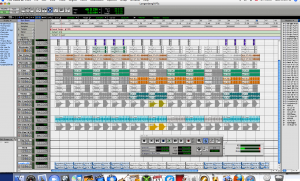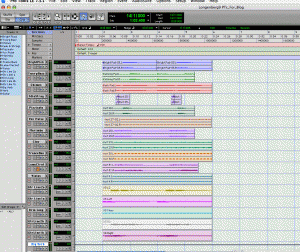The fact that so many A-list actors, directors and writers work on HBO projects proves the network’s creative culture is a breath of fresh air for these people. Because HBO’s bread is buttered directly by subscribers instead of advertisers their original content can tackle more controversial (read: more interesting) topics.
That same empowering culture is behind some of the most groundbreaking promos we’ve ever seen. One night I was grabbing a bite from the kitchen during a commercial break from Entourage when a song came on that stopped me dead in my tracks. It’s slow tempo, somber baritone vocals and studied chord changes sounded like nothing I’d ever heard come out of my TV speakers:
The song is “Addict Me” by The Local NYC – a song-writing duo of vocalist/lyricist Tim Champeaux and multi-instrumentalist Jon Cowherd. It reached #2 on the Amazon Roots Rock chart and compelled hardcore fans of the show True Blood to create their own unofficial montage using the song’s full length version.
On August 23rd I had the pleasure of conducting a phone interview with Champeaux who had just returned to New York from vacation. In addition to his music activities, Champeaux also carries a heavy schedule doing voice over work for many of the major TV networks.
MusicRevolution: Was the possibility of broadcast usage in your mind at all while recording the album Just Show Up?
Tim Champeaux: Not HBO particularly, but working in television and being a musician, it was never far from our minds. My voice over work has basically turned into a beautiful day job that started with Sex in the City. Jon works in TV too.
In a way it helped that one of the producers I work with at Sex in the City, CJ Harris, was a big fan of the record Just Show Up. When some big wigs at HBO said they wanted to go on a darker tip for this promo, she pitched it to the big guys and pushed it through the proper channels. They wanted something a little melancholy and we beat out a few significant bands for that spot. Remember to be cool with people- on your way up or way down!
MR: Where you coming from lyrically with this song?
TC: It was definitely autobiographical. The lyrics were born from living in the East village for a long time back in the day (around the late 90’s). It was a funkier part of NY then. I wasn’t using heavy drugs, but had some friends who were.
The line from the song “Are you feeling bullet proof?” came from a story about one of those friends when he ran out of money. He saw an ad for taking experimental pharmaceuticals and became a test subject. One day after that I saw him and asked how he’s doing. He said with a big, big smile “Bullet proof!”. I never forgot that.
The line “screams like a sin” also got a big response. Everybody from cutters to Christian rock people interpreted that lyric their own way.
MR: What music gear was used to create the sound effects at the song’s intro & outro?
TC: Jon had been working with a guitarist named Goffery Moore. Amazing guitarist. He’s really out of the box – guitar wise. He’s a sonic scaper.
He came up with that sheen that just gets you in the beginning. Jon put down some B3 and had him play whatever. I wouldn’t be surprised if it was the first thing Goffery played.
MR: Did it surprise you that “Addict Me” wound up being “the big hit” from Just Show Up?
TC: Yeah. The other songs are more positive. They don’t have that venom bite to them.
MR: Did the creation of that song take any unexpected turns that stand out in your mind?
TC: I didn’t love “Addict Me” when we first started writing it. There was something about it I didn’t love. When we got in the studio it really started going places. It wasn’t until it started going final that I said, “We really have something there.”
“We reached more people with that HBO promo than we could have reached anywhere else. It’s been awesome to see people love it so much. We want to really keep it going.”
Epilogue:
HBO was started in 1965 by a guy who literally ran cable underneath Manhattan because the tall buildings made normal signal reception difficult. The network’s long success began with a small number of New Yorkers willing to do a little extra to have great content in their world.
After a conversation with a seasoned veteran of the independent New York music scene like Champeaux, it seems obvious that same creative lifeblood still flows through New York City…well and true.
___________________________________________________
Mike Bielenberg is a professional musician and co-founder of http://www.musicrevolution.com, a production music marketplace where media producers and business owners can license high-quality, affordable music from a online community of musicians.

